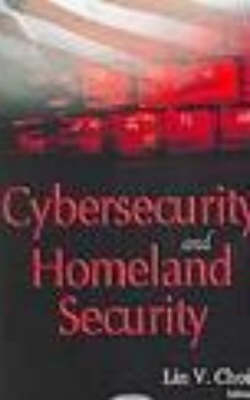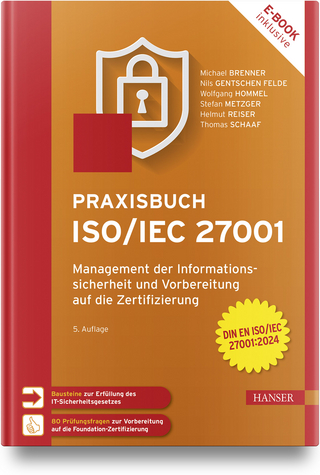
Cybersecurity & Homeland Security
Seiten
2006
Nova Science Publishers Inc (Verlag)
978-1-59454-728-7 (ISBN)
Nova Science Publishers Inc (Verlag)
978-1-59454-728-7 (ISBN)
Cybersecurity refers to three things: measures to protect information technology - the information it contains, processes, and transmits, and associated physical and virtual elements (which together comprise cyberspace); the degree of protection resulting from application of those measures; and the associated field of professional endeavour.
Even before the terrorist attacks of September 2001, concerns had been rising among security experts about the vulnerabilities to attack of computer systems and associated infrastructure. Yet, despite increasing attention from federal and state governments and international organisations, the defence against attacks on these systems has appeared to be generally fragmented and varying widely in effectiveness. Concerns have grown that what is needed is a national cybersecurity framework -- a co-ordinated, coherent set of public- and private-sector efforts required to ensure an acceptable level of cybersecurity for the nation. As commonly used, cybersecurity refers to three things: measures to protect information technology; the information it contains, processes, and transmits, and associated physical and virtual elements (which together comprise cyberspace); the degree of protection resulting from application of those measures; and the associated field of professional endeavour. Virtually any element of cyberspace can be at risk, and the degree of interconnection of those elements can make it difficult to determine the extent of the cybersecurity framework that is needed. Identifying the major weaknesses in U.S. cybersecurity is an area of some controversy. However, some components appear to be sources of potentially significant risk because either major vulnerabilities have been identified or substantial impacts could result from a successful attack -- in particular, components that play critical roles in elements of critical infrastructure, widely used commercial software, organisational governance, and the level of public knowledge and perception about cybersecurity. There are several options for broadly addressing weaknesses in cybersecurity. They include adopting standards and certification, promulgating best practices and guidelines, using benchmarks and checklists, use of auditing, improving training and education, building security into enterprise architecture, using risk management, and using metrics. These different approaches all have different strengths and weaknesses with respect to how they might contribute to the development of a national framework for cybersecurity. None of them are likely to be widely adopted in the absence of sufficient economic incentives for cybersecurity.
Even before the terrorist attacks of September 2001, concerns had been rising among security experts about the vulnerabilities to attack of computer systems and associated infrastructure. Yet, despite increasing attention from federal and state governments and international organisations, the defence against attacks on these systems has appeared to be generally fragmented and varying widely in effectiveness. Concerns have grown that what is needed is a national cybersecurity framework -- a co-ordinated, coherent set of public- and private-sector efforts required to ensure an acceptable level of cybersecurity for the nation. As commonly used, cybersecurity refers to three things: measures to protect information technology; the information it contains, processes, and transmits, and associated physical and virtual elements (which together comprise cyberspace); the degree of protection resulting from application of those measures; and the associated field of professional endeavour. Virtually any element of cyberspace can be at risk, and the degree of interconnection of those elements can make it difficult to determine the extent of the cybersecurity framework that is needed. Identifying the major weaknesses in U.S. cybersecurity is an area of some controversy. However, some components appear to be sources of potentially significant risk because either major vulnerabilities have been identified or substantial impacts could result from a successful attack -- in particular, components that play critical roles in elements of critical infrastructure, widely used commercial software, organisational governance, and the level of public knowledge and perception about cybersecurity. There are several options for broadly addressing weaknesses in cybersecurity. They include adopting standards and certification, promulgating best practices and guidelines, using benchmarks and checklists, use of auditing, improving training and education, building security into enterprise architecture, using risk management, and using metrics. These different approaches all have different strengths and weaknesses with respect to how they might contribute to the development of a national framework for cybersecurity. None of them are likely to be widely adopted in the absence of sufficient economic incentives for cybersecurity.
Lin V Choi, Editor
Preface; Creating a National Framework for Cybersecurity: An Analysis of Issues and Options; Cybersecurity for the Homeland: Report of the Activities and Findings by the Chairman and Ranking Member Subcommittee on Cybersecurity, Science, and Research and Development of the U.S. House of Representatives Select Committee on Homeland Security; Index.
| Erscheint lt. Verlag | 1.1.2006 |
|---|---|
| Verlagsort | New York |
| Sprache | englisch |
| Gewicht | 220 g |
| Themenwelt | Informatik ► Netzwerke ► Sicherheit / Firewall |
| Informatik ► Theorie / Studium ► Kryptologie | |
| Sozialwissenschaften ► Politik / Verwaltung | |
| ISBN-10 | 1-59454-728-9 / 1594547289 |
| ISBN-13 | 978-1-59454-728-7 / 9781594547287 |
| Zustand | Neuware |
| Informationen gemäß Produktsicherheitsverordnung (GPSR) | |
| Haben Sie eine Frage zum Produkt? |
Mehr entdecken
aus dem Bereich
aus dem Bereich
Das Lehrbuch für Konzepte, Prinzipien, Mechanismen, Architekturen und …
Buch | Softcover (2022)
Springer Vieweg (Verlag)
CHF 48,95
Management der Informationssicherheit und Vorbereitung auf die …
Buch (2024)
Carl Hanser (Verlag)
CHF 97,95


